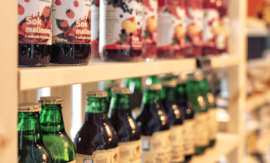Intended learning outcomes: Differentiate between pull logistics and push logistics. Describe the temporal synchronization between use and manufacturing with inventory control processes.
Effective and efficient business processes are a key factor with regard to a company’s performance. See the discussion in [Dave93] and [HaCh06], for example. The preceding Section 4.1 and this Section examine the elements and design of business processes.
Course section 4.2: Subsections and their intended learning outcomes

4.2 Push Logistics and Pull Logistics in the Design of Business Processes
Intended learning outcomes: Differentiate between pull logistics and push logistics. Describe the temporal synchronization between use and manufacturing with inventory control processes.

4.2.1 Pull Logistics
Intended learning outcomes: Produce an overview on the subprocesses of a business process in the enterprise, from order acquisition to fulfillment. Describe the interface between subprocesses according to the model “customer-supplier relationship with an internal order”.

4.2.2 Push Logistics
Intended learning outcomes: Describe the interface between subprocesses according to the model “simple sequence”. Explain the interface between subprocesses according to the model “partner relationship with overlapping subprocesses for handing over the order”.

4.2.3 The Temporal Synchronization between Use and Manufacturing with Inventory Control Processes
Intended learning outcomes: Differentiate between different inventory-control processes for temporal synchronization between use and manufacturing / procurement. Describe the example of pull logistics for order processing with end-product inventory replenishment after consumption.
Course 4: Sections and their intended learning outcomes

Course 4 – Business Process Analysis and Concepts for Planning & Control
Intended learning outcomes: Explain important techniques in business process engineering. Describe characteristic features relevant to planning & control in supply chains. Disclose fundamental concepts in logistics and operations management.

4.1 Elements of Business Process Management
Intended learning outcomes: Produce an overview on terms in business process engineering. Describe order management and graphical representation of logistics processes.

4.2 Push Logistics and Pull Logistics in the Design of Business Processes
Intended learning outcomes: Differentiate between pull logistics and push logistics. Describe the temporal synchronization between use and manufacturing with inventory control processes.

4.3 Important Techniques of Analysis in Business Process Engineering
Intended learning outcomes: Explain the organization-oriented process chart as well as the detailed analysis and time study of processes. Disclose manufacturing and service processes in the company-internal and transcorporate layout.

4.4 Characteristic Features Relevant to Planning & Control in Supply Chains
Intended learning outcomes: Produce an overview on principle and validity of characteristics in planning & control. Explain six features in reference to customer, and item or product or product family, five features in reference to logistics and production resources, as well as seven features in reference to the production or procurement order. Describe important relationships between characteristic features of transcorporate logistics in supply chains.
4.5 Branches, Production Types, and Concepts for Planning & Control
Intended learning outcomes: Describe branches of industry in dependency upon two characteristic features, "volume versus variety". Explain in detail production types and concepts for planning & control. Disclose selecting an appropriate branch model, production type, and concept for planning & control.

4.6 Summary
.

4.7 Keywords
.

4.8 Scenarios and Exercises
Intended learning outcomes: Differentiate between various concepts for planning & control within the company. Using process charts for synchronization between use and manufacturing with inventory control processes. Elaborate a basic process analysis as well as manufacturing processes in the company-internal layout.
